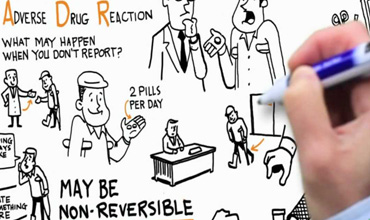Adverse Drug Reaction Reporting By Doctors in a Developing Country: a Case Study from Ghana

Abstract:
This paper reviewed an original article written by Sabblah et al on the adverse drug reaction reporting by medical doctors in a region in Ghana in 2012 but article originally published in 2014.
All over the world, spontaneous adverse drug reaction reporting is the mostly used method of monitoring the safety of drugs. This method is challenged with underreporting by healthcare professionals. The original article seeks to assess the knowledge of doctors about the adverse drug reaction (ADR) reporting system in Ghana, the rate of reportage and the attitude of the doctors on spontaneous reporting of ADRs. The method used was a cross-sectional survey and a self-administered questionnaire was used to collect data.
This review was to summarize and critique the content of the study and state possible recommendations. In critiquing, the authority, accuracy, currency and objectivity of the study were assessed. The study’s relevance, stability and graphs/tables were also assessed. In the article there were no recommendations or limitation to the study itself, recommendations were however made for improving spontaneous reporting. The results cannot be generalized so further studies are recommended in a national scope.
Keywords: Ghana; spontaneous reporting; ADR; doctors; review; underreporting
References:
[1.] Aagaard L, Stenver DI, Hansen EH. (2008) Structures and processes in spontaneous ADR reporting systems: a comparative study of Australia and Denmark. Pharm. World Sci. 30(5):563-570. Doi: 10.1007/s11096-008-9210-y
https://www.ncbi.nlm.nih.gov/pubmed/18350372
[2.] Ahmad SR. (2003) Adverse drug event monitoring at the Food and Drug Administration. J Gen Intern Med. 285:437–443
https://www.ncbi.nlm.nih.gov/pmc/articles/PMC1494803/
[3.] Akshaya Srikanth Bhagavathula, et al. (2016) Health Professionals' Knowledge, Attitudes and Practices about Pharmacovigilance in India: A Systematic Review and Meta-Analysis. PLoS One, 11(3): e0152221. doi:10.1371/journal.pone.0152221
https://www.ncbi.nlm.nih.gov/pmc/articles/PMC4807086/
[4.] Blenkinsopp A, Wilkie P, Wang M, Routledge PA. (2007) Patient reporting of suspected adverse drug reactions: a review of published literature and international experience. Br J ClinPharmacolFeb;63(2):148-156. DOI: 10.1111/j.1365-2125.2006.02746.
http://onlinelibrary.wiley.com/doi/10.1111/j.1365-2125.2006.02746.x/full
[5.] Belton KJ. (1997) Attitude survey of adverse drug reaction reporting by health care professionals across the European Union. The European Pharmacovigilance Research Group. Eur. J. Clin. Pharmacol 52(6):423-7.
https://www.ncbi.nlm.nih.gov/pubmed/9342576
[6.] Bello SO, Umar MT.(2011) Knowledge and attitudes of physicians relating to reporting of adverse drug reactions in Sokoto, north-western Nigeria. Ann Afr Med 10(1): 13-18. Available from:
[7.] Enwere OO, Fawole OI. (2008) Adverse drug reactions reporting by physicians in Ibadan, Nigeria. Pharmacoepidemiology and Drug Saf. 17:517–522.
https://www.ncbi.nlm.nih.gov/pubmed/18404621/
[8.] GulnihalOzcan, (2016) Adverse Drug Reaction Reporting Pattern in Turkey: Analysis of the National Database in the Context of the First Pharmacovigilance Legislation. Drugs Real World Outcomes, Mar; 3(1): 33–43.doi: 10.1007/s40801-015-0054-1 https://www.ncbi.nlm.nih.gov/pmc/articles/PMC4819489/
[9.] Haggar H. Ampadu et al. (2016) Adverse Drug Reaction Reporting in Africa and a Comparison of Individual Case Safety Report Characteristics Between Africa and the Rest of the World: Analyses of Spontaneous Reports in VigiBase®. Drug Saf, 39: 335–345. doi: 10.1007/s40264-015-0387-4
https://www.ncbi.nlm.nih.gov/pmc/articles/PMC4796322/
[10.] Inman WH. (1996) Attitudes to adverse drug-reaction reporting. Br J ClinPharmacol 41:433-5. https://www.ncbi.nlm.nih.gov/pubmed/8735689/
[11.] JoëlleBerrewaerts et al. (2016) Patient Participation and the Use of Ehealth Tools for Pharmacovigilance. Front Pharmacol. 7: 90. doi: 10.3389/fphar.2016.00090
https://www.ncbi.nlm.nih.gov/pmc/articles/PMC4827142/
[12.] Pal S et al. (2011) The world medicines situation 2011: Pharmacovigilance and safety of medicines. Geneva: WHO, 2011 [cited 2016, 23 September]. Available from:
http://apps.who.int/medicinedocs/documents/s18771en/s18771en.pdf
[13.] RoslianaRosli (2016) A Retrospective Analysis of Spontaneous Adverse Drug Reactions Reports Relating to Paediatric Patients. PLoS One, 11(6): e0155385. doi: 10.1371/journal.pone.0155385
https://www.ncbi.nlm.nih.gov/pmc/articles/PMC4889073/
[14.] The WHO Pharmacovigilance Reporting Trends. [Cited 2016, September 2016].Available from: http://www.whoumc.org/DynPage.aspx?id=108476&mn1=7347&mn2=7252&mn3=7322&mn4=7558
[15.] Vergeire-Dalmacion G, Castillo-Carandang NT, Juban NR, Amarillo ML, Tagle MP, Baja ES (2015) Texting-Based Reporting of Adverse Drug Reactions to Ensure Patient Safety: A Feasibility Study. JMIR Public Health Surveill, Jul-Dec; 1(2): e12 DOI: 10.2196/publichealth.4605 https://www.ncbi.nlm.nih.gov/pmc/articles/PMC4869238/
[16.] Yun Mi Yu et al. (2016) Predictive Factors of Spontaneous Reporting of Adverse Drug Reactions among Community Pharmacists. PLoS One, 11(5): e0155517. doi: 10.1371/journal.pone.0155517

